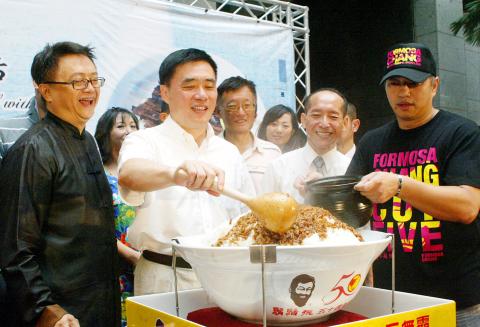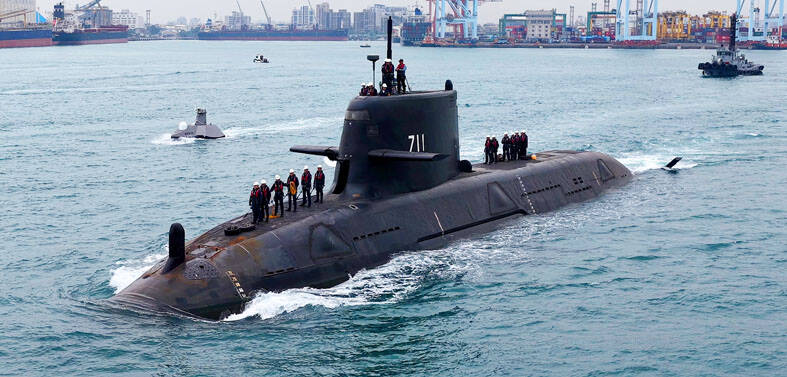The Taipei City Government yesterday prepared and dished out more than 1,000 bowls of braised pork on rice free of charge in an attempt to set the record straight about the Taiwanese delicacy after the dish’s origins were mistakenly attributed to China in Michelin’s Green Guide Taiwan.
Known as luroufan, the Michelin guide labeled the dish as an “elemental staple of Shandong [Province] cuisine.”
“Today we’re here to let everyone know that luroufan is genuine Taiwanese cuisine, a national delicacy, not a ‘Shandong-style’ dish,” Taipei Mayor Hau Lung-bin (郝龍斌) said during a press conference to defend the honor of the dish.

Photo: CNA
After finding out Michelin listed the dish as originating from Shandong Province in China, Hau wrote to the group’s editorial manager Jonathan Gilbert and requested a revision.
Hau wants to have the original text replaced with: “Braised Pork Rice, a true classic Taiwanese street delicacy.”
“This satisfying, yet inexpensive Taiwanese traditional savory dish is a meal in itself,” Hau wrote in an e-mail dated July 6, along with a short introduction to the Taiwanese dish.
Florent Bonnefoy, Michelin travel guides manager, answered in an e-mail that the group conducts regular updates and revisions to provide accurate information.
“As we hope to have reprints and further editions of our Taiwan Green Guide, we will naturally input the necessary changes and updates,” Bonnefoy said in response.
He did not say whether Michelin would change the description.
Liang Yu-hsiang (梁幼祥), a gourmet reviewer in Taiwan, also presented written proof from the Beijing-based Chinese Food Culture Research Association at the press conference, which said “there is no such food item in Shandong.”
“It is definitely a local delicacy,” Liang said. “Maybe there are nuances [in names] between northern and southern Taiwan, but it has nothing to do with Shandong.”
The Taiwanese public also found it hard to accept that China was given credit for a Taiwanese dish.
“I have been enjoying this traditional snack food all my life, and it’s very Taiwanese to me,” a woman standing in line for the free luroufan said.
The city blamed the mix-up on the first character in the Chinese name of the dish, lu (魯), which is also an alternate name for Shandong Province, where the State of Lu reigned about 2,200 years ago. The city is now urging the public to start using a homonym which means braising (滷), to avoid confusion.
The organizers added that several restaurants and vendors are scheduled to host daylong promotional campaigns.

NUMBERS IMBALANCE: More than 4 million Taiwanese have visited China this year, while only about half a million Chinese have visited here Beijing has yet to respond to Taiwan’s requests for negotiation over matters related to the recovery of cross-strait tourism, the Tourism Administration said yesterday. Taiwan’s tourism authority issued the statement after Chinese-language daily the China Times reported yesterday that the government’s policy of banning group tours to China does not stop Taiwanese from visiting the country. As of October, more than 4.2 million had traveled to China this year, exceeding last year. Beijing estimated the number of Taiwanese tourists in China could reach 4.5 million this year. By contrast, only 500,000 Chinese tourists are expected in Taiwan, the report said. The report

Temperatures are forecast to drop steadily as a continental cold air mass moves across Taiwan, with some areas also likely to see heavy rainfall, the Central Weather Administration (CWA) said. From today through early tomorrow, a cold air mass would keep temperatures low across central and northern Taiwan, and the eastern half of Taiwan proper, with isolated brief showers forecast along Keelung’s north coast, Taipei and New Taipei City’s mountainous areas and eastern Taiwan, it said. Lows of 11°C to 15°C are forecast in central and northern Taiwan, Yilan County, and the outlying Kinmen and Lienchiang (Matsu) counties, and 14°C to 17°C

STEERING FAILURE: The first boat of its class is experiencing teething issues as it readies for acceptance by the navy, according to a recent story about rudder failure The Hai Kun (海鯤), the nation’s first locally built submarine, allegedly suffered a total failure of stern hydraulic systems during the second round of sea acceptance trials on June 26, and sailors were forced to manually operate the X-rudder to turn the submarine and return to port, news Web site Mirror Daily reported yesterday. The report said that tugboats following the Hai Kun assisted the submarine in avoiding collisions with other ships due to the X-rudder malfunctioning. At the time of the report, the submarine had completed its trials and was scheduled to begin diving and surfacing tests in shallow areas. The X-rudder,

DEMAND: The government should enact regulations in line with Austria and Germany to incorporate vegan nutrition into school meals, an advocate said More than 1,000 people yesterday marched in Taipei to promote veganism, calling for legislation to incorporate vegan diets into school lunches and the national net zero emissions program. Participants gathered on Ketagalan Boulevard in front of the Presidential Office Building for the march, which was organized by the Vegan Action Network (VAN). Former ambassador to Chad Chiu Chung-jen (邱仲仁), actor Yankee Yang (楊子儀) and actress Cindy Lien (連俞涵) attended the event. VAN member Marianne Chao (趙梅君) said that the campaign aimed to urge the government to promote vegan diets across schools and government agencies via legislation and national policies, which would help build